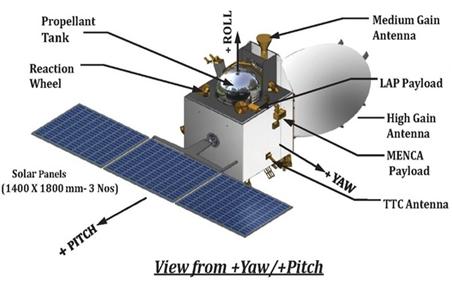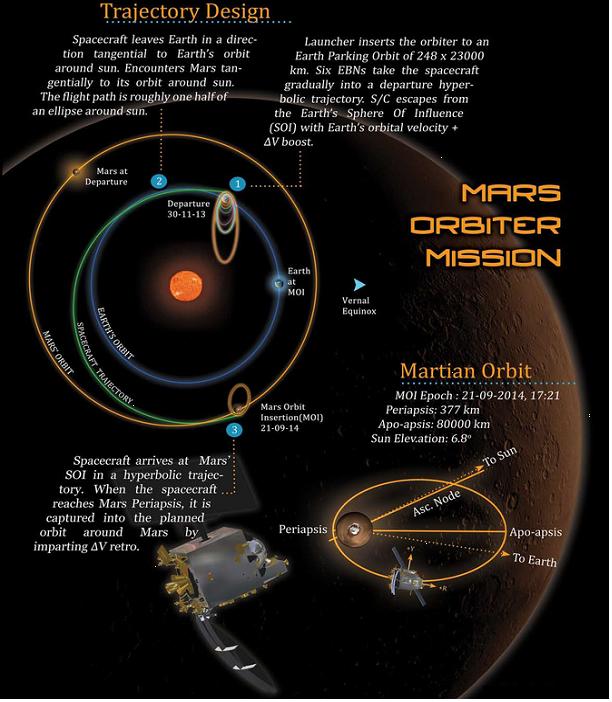Envis Centre, Ministry of Environment & Forest, Govt. of India
Printed Date: Friday, January 9, 2026
Mars Orbiter Mission
Mars Orbiter Mission, Mangalyan is India's first interplanetary mission to planet Mars with an orbiter craft designed to orbit Mars in an elliptical orbit. The Mission is primarily technological mission considering the critical mission operations and stringent requirements on propulsion and other bus systems of spacecraft. It has been configured to carry out observation of physical features of mars and carry out limited study of Martian atmosphere with following five payloads:
- Mars Colour Camera (MCC)
- Thermal Infrared Imaging Spectrometer (TIS)
- Methane Sensor for Mars (MSM)
- Mars Exospheric Neutral Composition Analyser (MENCA)
- Lyman Alpha Photometer (LAP)
|
Lift-off Mass
|
1337 kg
|
|
Structures
|
Aluminum and Composite Fiber Reinforced Plastic (CFRP) sandwich construction-modified I-1 K Bus
|
|
Mechanism
|
Solar Panel Drive Mechanism (SPDM), Reflector & Solar panel deployment
|
|
Propulsion
|
Bi propellant system (MMH + N2O4) with additional safety and redundancy features for MOI. Proplellant mass:852 kg
|
|
Thermal System
|
Passive thermal control system
|
|
Power System
|
Single Solar Array-1.8m X 1.4 m - 3 panels - 840 W Generation (in Martian orbit), Battery:36AH Li-ion
|
|
Attitude and Orbit Control System
|
AOCE (Attitude and Orbit Control Electronics): with MAR31750 Processor
Sensors: Star sensor (2Nos), Solar Panel Sun Sensor (1No), Coarse Analogue Sun Sensor
Actuators: Reaction Wheels (4Nos), Thrusters (8Nos), 440N Liquid Engine
|
|
Antennae:
|
Low Gain Antenna (LGA), Mid Gain Antenna (MGA) and High Gain Antenna (HGA)
|
|
Launch Date
|
Nov 05, 2013
|
|
Launch Site
|
SDSC SHAR Centre, Sriharikota, India
|
|
Launch Vehicle
|
PSLV - C25
|


1) India is the first country to conduct a successful Mars mission 'Mangalyaan' on its first try after US, European Space Agency and the former Soviet Union.
2) Mangalyaan's on-orbit mission life is less than ten months.
3) The essential target of the mission is to showcase nation's rocket launch frameworks, shuttle building and operations capacities.
4) Mangalyaan is equipped with at least five solar powered equipments which will accumulate the information on Martian Climate and water, if it still exists on Mars. The Orbiter is expected to investigate the surface of the planet, availability of minerals and environment.
5) The closest and farthest points of the Orbiter from Mars will be 365 Km and 80,000 Km respectively.
6) The Mission was carried out in a period of 15 months, utilizing an amount close to Rs.450 crores.
7) The Indian Deep Space Network will take care of navigation and keeping a check on the operations of the mission. NASA's Deep Space Network will assist in administrations amid the non-visible time of the Indian Deep Space Network.
8) The dry mass of the shuttle is 500 Kilos while will carry 850 Kilos of Propellant and Oxidizer to fuel the engine.

Source:ISRO